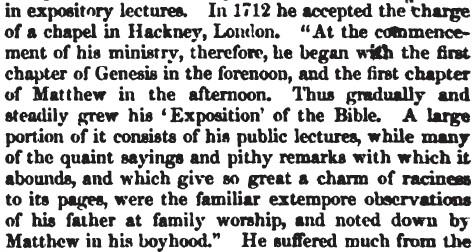 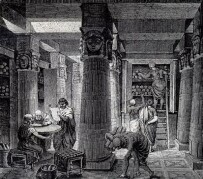  |
Occasional Postings of a Lover of Archaic Books
"a book... I have found" II Chron. 34:14,15
| <2015 | 2017> |
December 26, 2016
The Still Hour
Spurgeon, in a very challenging sermon, True Prayer—True Power! (text, audio),
recommends a "a sweet little book":Reading the other day in a sweet little book, which I would commend to the attention of you all, written by an American author who seems to know the power of prayer thoroughly, and to whom I am indebted for many good things—a little book called The Still Hour, I met with a reference to a passage in the book of Daniel, the tenth chapter I think, where, as he says, the whole machinery of prayer seems to be laid bare. Daniel is on his knees in prayer, and Michael the archangel come to him. He talks with him and tells him that as soon as ever Daniel began to set his heart to understand, and to chasten himself before God, his words were heard, and the Lord had dispatched the angel. Then he tells him in the most business-like manner in the world, "I should have been here before, but the Prince of Persia withstood me; nevertheless the prince of thy nation helped me, and I am come to comfort and instruct thee."
See now. God breathes the desire into our hearts, and as soon as the desire is there, before we call he begins to answer. Before the words have got half way up to heaven, while they are yet trembling on the lip—knowing the words we mean to speak—he begins to answer them, sends the angel; the angel comes and brings down the needed blessing. Why the thing is a revelation if you could see it with your eyes.
October 19, 2016
The Old Road -- The Precious
Doctrines of Grace
From The Spurgeon Birthday Book: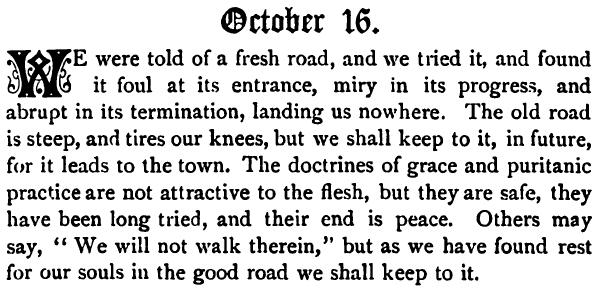
October 15, 2016
Surprise! Universe has 2 trillion
galaxies
One of the most amazing Hubble images is of Deep Field,
which took the Hubble telescope 10 days to image... but only God's
spoken word on the 4th day to create, as if saying: By the way, "...the
stars also."From the Online Bible:
From Clarke's Commentary -- 258,000 stars:
https://www.theguardian.com/science/2016/oct/13/hubble-telescope-universe-galaxies-astronomy
Universe has 2 trillion galaxies, astronomers say
Hubble telescope images from deep space were collected over 20 years to solve the puzzle of how many galaxies the cosmos harborsThere are a dizzying 2 trillion galaxies in the universe, up to 20 times more than previously thought, astronomers reported on Thursday. The surprising finding, based on 3D modeling of images collected over 20 years by the Hubble Space Telescope, was published in the Astronomical Journal.
Scientists have puzzled over how many galaxies the cosmos harbors at least since US astronomer Edwin Hubble showed in 1924 that Andromeda, a neighboring galaxy, was not part of our own Milky Way. But even in the era of modern astronomy, getting an accurate tally has proven difficult.
To begin with, there is only part of the cosmos where light given off by distant objects has had time to reach Earth. The rest is effectively beyond our reach. And even within this “observable universe”, current technology only allows us to glimpse 10% of what is out there, according to the new findings.
“It boggles the mind that over 90% of the galaxies in the universe have yet to be studied,” commented Christopher Conselice of the University of Nottingham, who led the study. “Who knows what interesting properties we will find when we observe these galaxies with the next generation of telescopes?” he said in a statement.
Using deep space images from Hubble, Conselice and his team painstakingly converted them into 3D to measure the number of galaxies at different times in the history of the universe. The analysis reached back more than 13bn years – very near the time of the “Big Bang” thought to have given birth to the universe.
A galaxy is a system of millions or billions or stars, held together by gravity, with planetary systems within them. Using new mathematical models, the astronomers were able to infer the number of “invisible” galaxies beyond the reach of telescopes, leading to the surprising realization that the vast majority are too faint and far away to be seen.
When the universe was only a few billion years old, there were 10 times as many galaxies in a given volume of space as there are today, the findings suggest. This in turn suggests that “significant evolution must have occurred to reduce their number through extensive merging of systems”.
This article was amended on Friday 14 October 2016 to correct the headline, which had wrongly stated that there are 2tn more galaxies than previously thought.
October 10, 2016
Every man who comes to Christ
shall be saved
From Free Will — A Slave
sermon by C. H. Spurgeon, December 2, 1855:"But," says one, "suppose all the world should come, would Christ receive them?" Certainly, if all came; but then they won't come. I tell you all that come—aye, if they were as bad as devils, Christ would receive them; if they had all sin and filthiness running into their hearts as into a common sewer for the whole world, Christ would receive them.
Another says, "I want to know about the rest of the people. May I go out and tell them—Jesus Christ died for every one of you? May I say—there is righteousness for everyone of you, there is life for every one of you?" No; you may not. You may say—there is life for every man that comes. But if you say there is life for one of those that do not believe, you utter a dangerous lie. If you tell them Jesus Christ was punished for their sins, and yet they will be lost, you tell a wilful falsehood. To think that God could punish Christ and then punish them—I wonder at your daring to have the impudence to say so!
June 24, 2016
Two books to help put our
problems into perspective
Ever
feel you are being overwhelmed by the trials and
tribulations of life? Here are two books to make us realize just how
small our problems are compared to what many faced long ago:John G. Paton, Missionary to the New Hebrides - An Autobiography (1891) - an amazing story and one of the most gripping tales of missionary work in print
June 24, 2016
Foreigners Who Changed Japan - Tanegashima and the Portuguese
I've started an English-Japanese series called "Foreigners Who Changed Japan" (日本を変えた外国人). The series starts out with the first Europeans who in the mid-16th century arrived in Japan, landing on the island of Tanegashima, and changing Japan’s history forever.May 21, 2016
God's Comfort
"As one whom his mother comforteth, so will I comfort you; and ye shall
be comforted in Jerusalem." Isa 66:13Excerpt from a sermon outline by Nicholson, 1862:


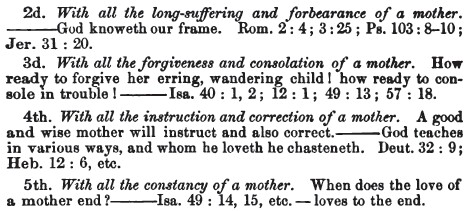
May 4, 2016
Christian history in Kumamoto
Updates and related info about the Kumamoto earthquakes can be found
daily in the news here in Japan. But Kumamoto was affected in another
very great way nearly 150 years ago when foreign teachers were brought
in to help modernize Japan. Among them was a godly man named Leroy L.
Janes.Here is a chapter about those early years when Christianity first came to Kumamoto, with one of the results being the formation of a group of Japanese Christians who would have a huge influence on their country -- the Kumamoto Band (PDF file).
Sadly, the Janes' home was demolished in the earthquake, but hopefully they will be able to salvage all of the important historical articles that were displayed inside.
BEFORE:

AFTER:
March 25, 2016
Large Ships of Antiquity
VERY interesting piece by Larry Pierce (who developed one of the best Bible software programs ever) on old ships and how huge they were. The following is from his website:We should not be surprised that we are awash today with such so called “experts”. The Apostle Peter warned us this would be the case. It has become fashionable to scoff at anything biblical. Noah’s ark has never failed to be the target of skeptics and the butt of many jokes. Everyone knows you cannot build a boat as large as Noah did from wood, even using today’s advanced technology. Only since ships were made of steel, in the last hundred years or so, has man been able to build a larger ship than Noah’s ark. These so called experts display their ignorance of history in making such statements. Lets look at what ships the ancients actually did build, some of which were almost as large as the ark.
Rise in Technology of the Ancients
In the writings of Pliny, we discovered the following table relating to ships of antiquity. This documents the rapid advances the ancients made in shipbuilding technology in just a few centuries. The time period in the table covers from about the seventh century BC to the end of the third century BC.
Vessel / Inventor / Authority / Approximate Time
double-banked / the Erythraens / Damastes / 7th c. BC
trireme / Aminocles of Corinth / Thucydides / 6th c. BC
quadrireme / the Carthaginians / Aristotle / 5th c. BC
quinquereme / the Salaminians / Mnesigiton / 4th c. BC
galleys of six banks / the Syracusans / Xenagoras
up to ten banks / Alexander the Great / Mnesigiton
up to twelve / Ptolemy / Soter Philostephanus / 3rd c. BC
up to fifteen / Demetrius, son of Antigonus / Philostephanus
up to thirty / Ptolemy / Philadelphus Philostephanus
up to forty / Ptolemy / Philopator Tryphon Philostephanus
When we think of warships of antiquity, we think of the tiny ships that were shown in a movie like Ben Hur. They had about fifty or so men and a single tier of oars. This was the best Hollywood could do on a limited budget and reflects our evolutionary thinking that the ancients were primitive compared to us. While we may flatter ourselves with our supposed knowledge of ancient history, the actual facts, that come down to us, tell us another story. From this table in Pliny, we can see a rapid rise in technology over a few hundred years which culminated in a ship of forty tiers of oars. (When we say forty tiers we mean forty levels of rowers!) Now the question is, do we have any descriptions of these ships so we can comprehend how large they really were? Fortunately, we have a good description of one of the early third century ships and an excellent description of the largest ship Pliny lists.
The Leontifera
There was a naval battle in the Aegean Sea in 280 BC. The following is Ussher’s description of what happened:
When Antigonus, surnamed Gonatas, the son of Demetrius Poliorcetes, heard how Seleucus was murdered, he made an expedition into Macedonia. He planned to get there before Ceraunus could with his army and naval forces. However, Ceraunus had all Lysimachus’ fleet in readiness, and set out and met him in a good battle formation at sea. In his navy, ships were sent from Heraclea in Pontus, some of six, some of five tiers of oars. These kinds of ships were called Aphracta. The largest ship of all had eight tiers of oars and was called the Leontifera. She was admired by all for her large size and exquisite construction. In her were a hundred oars per tier, so that on each side there were eight hundred rowers which made sixteen hundred in all. On the upper deck or hatches there were twelve hundred fighting men who were under two special commanders. When the battle began, Ceraunus won and Antigonus was forced to flee with all his navy. In this fight, the ships from Heraclea performed the best and among them the Leontifera did the best of all … ”
We are not given the dimensions of this ship. However, for a hundred men to sit on one tier of oars, each one would have to be at least three feet apart which is the approximate distance between airline seats. Has anyone ever complained of having too much space between airline seats! Allowing for a bow and a stern, this ship could easily have been four or five hundred feet long. (The next ship we describe had fifty oars in a tier and was over four hundred feet long) If I was in that battle in a ship, I definitely would not want to be in the path of the business end of the Leontifera’s ramming prow. Also consider that these battles were not fought in an afternoon! This ship could have been at sea for a few days before and after this battle. With a crew compliment of over three thousand men, think of the provisions they would have to carry. They would need somewhere to sleep too!
Other Large Ships
Plutarch briefly describes the fleet which Demetrius built around 294 BC. These were the largest ships built at that time. Although Plutarch gives no dimensions, he does state the following:
“Up until this time, no man had seen a ship of fifteen or sixteen banks of oars. … However, in the ships of Demetrius their beauty did not mar their fighting qualities, nor did the magnificence of their equipment rob them of their usefulness, but they had a speed and effectiveness which was more remarkable than their great size.”
The Grand-Daddy of Antiquity
Athenaeus gives us a detailed description of a very large warship.
Ptolemy Philopator (c. 244-205 BC) built a large warship. It was four hundred and twenty feet long, fifty-seven feet wide and seventy-two feet high to the top of her gunwale. From the top of her stern post to the water line was seventy-nine and a half feet. It had four steering oars forty-five feet long. It had forty tiers of oars. The oars on the uppermost tier were fifty-seven feet long. The oars were counter balanced with lead to make them easy to handle. It had a double bow and a double stern and carried seven rams of which one was the leader and the others were of gradually reducing size. It had twelve under-girders nine hundred feet long. She was manned by four hundred sailors to handle the rigging and the sails, four thousand rowers and two thousand and eight hundred and fifty men in arms for a total of seven thousand and fifty men. This ship was too large to be of much practical use.
Some things of interest about this ship. First, there are no forests worth mentioning in Egypt. All the lumber had to be imported from elsewhere, likely Lebanon. This ship had a crew compliment that was almost twice as large as the compliment of the largest aircraft carrier we have ever built! The size of the ship approximated the size of Noah’s ark. Like Noah’s ark, it would have to carry provisions and supplies for all these men. Oh for a time machine to go back and capture this ship on film!
Athenaeus describes other very large ships and boats of antiquity. One ship had a catapult designed by Archimedes that could hurl a hundred and twenty pound stone over six hundred feet.
Conclusion
What should we learn from this?
Firstly, we are not as smart as we think we are! Just because we cannot duplicate something that was done thousands of years ago, does not mean the ancients could not do it either!
Secondly, we should learn from history. True history supports the Bible and we have nothing to fear from the study of it. In fact, we have much to learn. From these accounts we have given, it is obvious mankind was able to build huge ships that rivaled Noah’s ark in size. We do not know how it was done, but they did it!
The next time someone says that it is impossible for the ancients to build a ship as large as Noah’s Ark, give the same reply Jesus gave many times to his skeptics: “Have ye not read … ?”
March 16, 2016
Darwin and missions
A few excerpts from an 1888 book entitled (take a long breath!):"The great value and success of foreign missions: Proved by distinguished witnesses: being the testimony of diplomatic ministers, consuls, naval officers, and scientific and other travelers in heathen and Mohammedan countries; together with that of English viceroys, governors, and military officers in India and in the British Colonies: also leading facts and late statistics of the missions."Interesting to note that Darwin supported missions, and considered the work in Japan "the greatest wonder in the world." Darwin would have done well to produce a book about missionary efforts and their influence on the progress and "evolution" of nations.



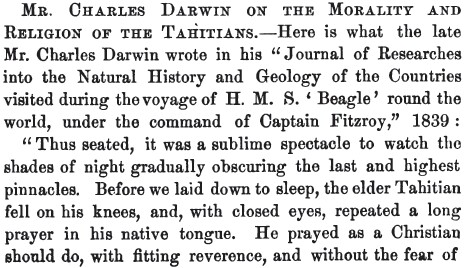


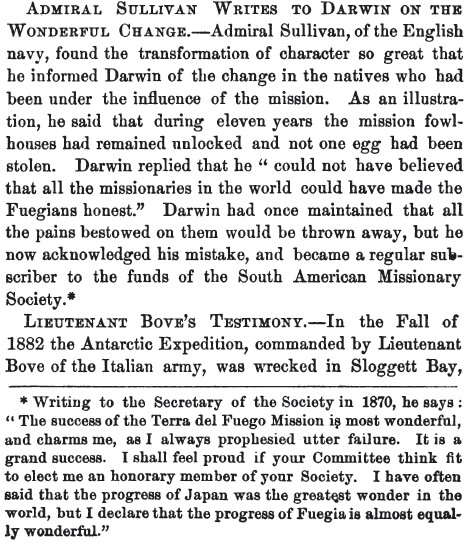
March 9, 2016
Two Bridges
As we remember the life and work of Jerry Bridges, there is another Bridges that must not be forgotten. Spurgeon called Charles Bridges' Exposition "the best work on Proverbs." Here is a portion from the 3rd chapter, full of spiritual nourishment: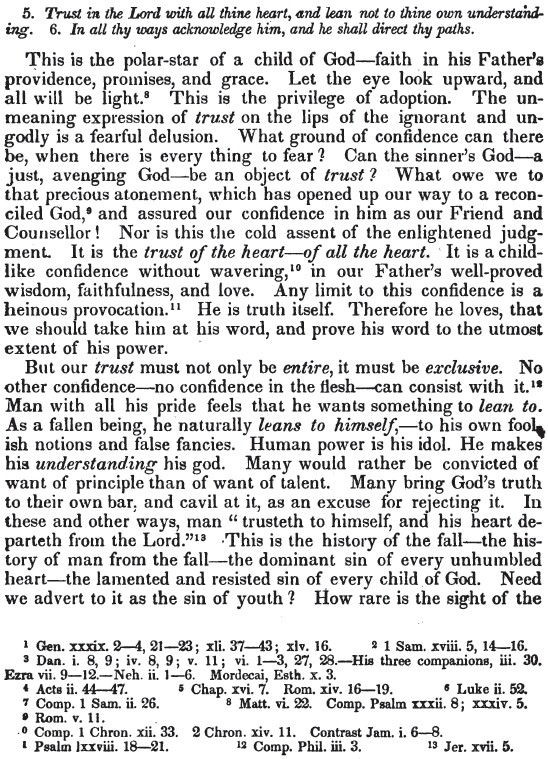

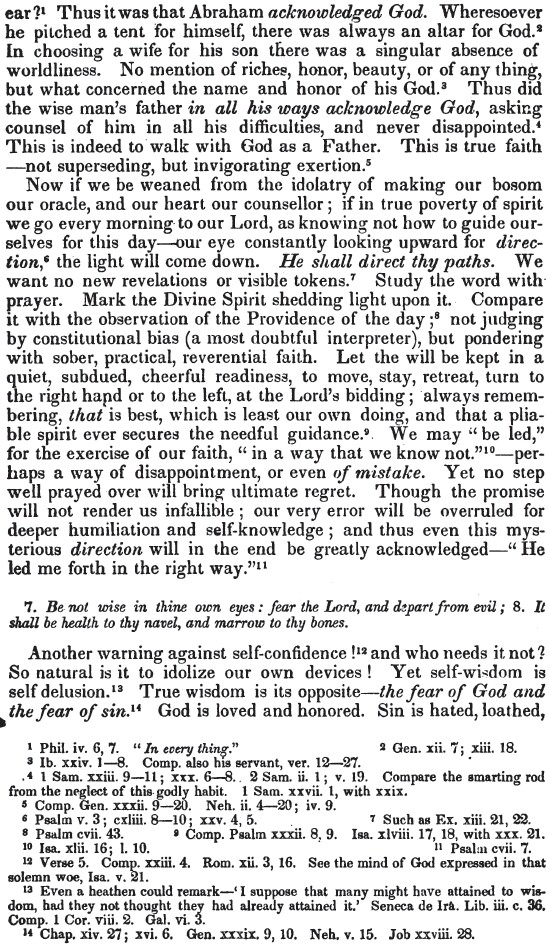
February 29, 2016
Spurgeon on sufficient grace

February 19, 2016
US and Japan Literacy
Interesting forward from FBIS on "The Old Deluder Act." It is a blessing from the Lord that we know how to read and write, for it is all biblically centered.Japanese leaders understood the need for literacy among the populace as well -- an interesting synopsis is here:
https://www.reddit.com/r/AskHistorians/comments/27vf5f/literacy_rates_in_premodern_japan_why_was/
Of special note is the influence of "Dutch Learning" (Rangaku) -- even as our Pilgrim fathers benefited from the Dutch due to the Reformation taking root there in a profound way (including Tyndale's translation, though sadly martyred there!), so also did the Japanese, by the Dutch sowing the seed of future Protestant evangelism through literature. Quite a number of Japanese were influenced, leading to great changes in Japan.
The Old Deluder Act and America’s Literacy
From its inception, America was a highly literate society, and its literacy was because of the Bible."The Puritans strongly supported education. Literacy, they believed, is necessary in order to read and understand the Bible and its principles. Literacy and education were also important to them because a civil republican/democratic self-government require informed, knowledgeable voters and representatives who understand the laws of the colony. Literacy and education also provide communities with competent citizens of various professions. The Puritans, therefore, wanted to spread knowledge to everyone for the benefit of the community" (Angela Kamrath, The Miracle of America).
Benjamin Rush, signer of the Declaration of Independence, said, "... the only foundation for a useful education in a republic is to be laid in religion. Without this, there can be no virtue, and without virtue there can be no liberty, and liberty is the object and life of all republican governments" (Of the Mode of Education Proper in a Republic, 1798).
The Massachusetts School Law of 1642 required all children to be taught to read and write by their parents or masters of apprenticeship. The children were to be able "to read and understand the principles of religion and the capital laws of this country."
The Old Deluder Satan Act of 1647 in the Massachusetts Bay Colony went further, requiring that every town and community with over 50 families set up schools and hire schoolmasters. The goal was so that "the old deluder, Satan [would not] keep men from the knowledge of the Scriptures." The particular fear was that the Catholic Church would be able to deceive an illiterate people as she had been accustomed to doing in Europe. The law began as follows: "It being one chief project of that old deluder, Satan, to keep men from the knowledge of the Scriptures, as in former times keeping them in an unknown tongue [Latin], so in these later times by persuading from the use of tongues [illiteracy], that so at least the true sense and meaning of the Original might be clouded with false glosses of saint-seeming deceivers; and that learning may not be buried in the graves of our forefathers in Church and Commonwealth, the Lord assisting our endeavours: it is therefore ordered by this Court and Authority thereof; that every township in this jurisdiction, after the Lord hath increased them to the number of fifty householders, shall then forthwith appoint one within their town to each all such children as shall resort to him to write and read..."
The New England Code of 1655 required that children be made "able duly to read the Scriptures ... and in some competent measure to understand the main grounds and principles of Christian Religion necessary to salvation."
February 9, 2016
Islam and Roman Catholicism
"What an amazing prophecy is this!... a comfort to all the saints..."Daniel 12 explained succinctly:
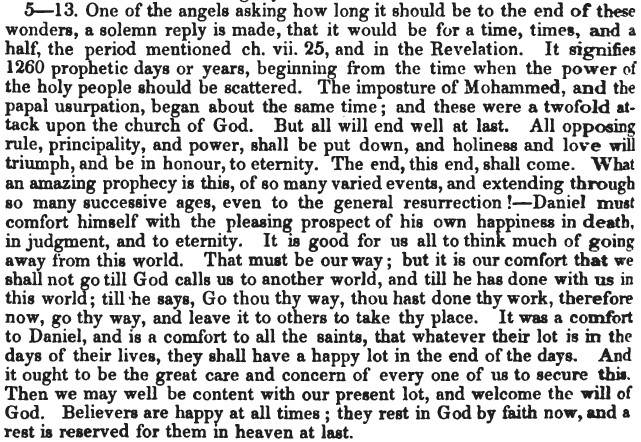
February 5, 2016
An allegory which I have never forgotten -- A few ears of wheat
"He led them forth by the right way, that they might go to a city of habitation." Psalm 107:7
Some years ago I heard an allegory which I have never forgotten. It often comes back to me when I think of the way in which the Lord leads His people.
The fable runs that a few ears of wheat were growing in the corner of a field, and it was promised to this wheat that it would one day be brought before the Queen. But by-and-by the mower came with his sharp scythe and cut the wheat, and feeling the sharpness of the scythe, it said, "I shall never stand before the Queen!" Presently it was laid in the wagon, and pressed and borne down by the other sheaves, and again arose the cry of distress and despair. But, more than this, it was laid on the threshing-floor, and the heavy flail came down upon it. It was taken to the mill, and cut and cut and cut; then it was kneaded into bread; and at last it was placed in the hot burning oven. Again and again was heard the cry of utter, hopeless despair. But at length the promise was fulfilled, and the bread was placed on the Queen's table!
There is a great spiritual truth beneath the fable. Christians are God's wheat, sprung from the incorruptible seed of His Word, and from the precious seed of the crucified, buried body of our Lord--and He purposes that one day they shall stand before Him! But there needs much preparation.
There comes the sharp scythe of bereavement--the loss of child or parent or spouse.
There comes the oppressive burden of care.
There comes the severe tribulation (the very word signifies threshing), seasons of adversity and disappointment.
There comes the mill, the trial that utterly breaks us down, and fills the whole spirit with distress.
There comes the hot furnace of agonizing pain or fear.
All these are doing their appointed work, stirring up faith and prayer, humbling to the very dust--and yet lifting up the Christian, by leading him nearer to God, and enabling him at length to say, "It is good for me that I have been afflicted!"
February 5, 2016
A mass of rubies, emeralds, diamonds, in a nugget of gold
From Spurgeon's The Cheque Book of the Bank of Faith: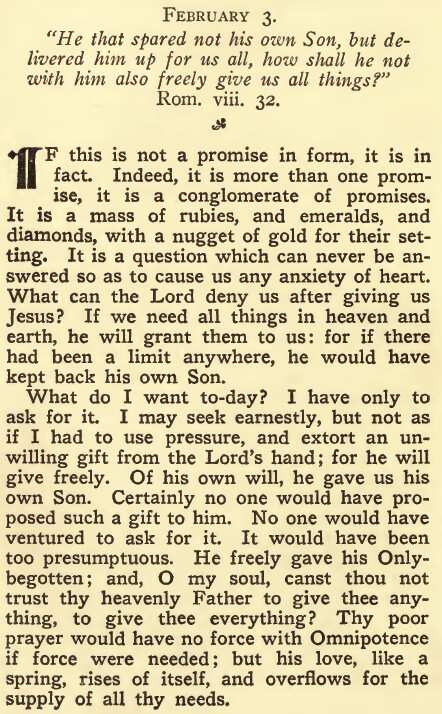
February 4, 2016
To all us Kafirs...
In case you didn't know where you stand...Every Non-Muslim Is a Kafir
The following is excerpted from THE BIBLE AND ISLAM. In light of today's news events, we do well to ask what the Bible says about Islam. Islam controls a large part of the world and is on a jihadic rampage that hasn't been seen in hundreds of years. This far-reaching book describes Islam's beginning and history, the doctrine of Allah, the Quran, Islam and salvation, the three stages of jihad, the Koran's doctrine of abrogation, Islam and Judaism, Islam and Christianity, Sharia law, jihad and world conquest, Islam and the slave trade, Islam as a judgment on apostate Christianity and apostate Israel, Islam's divisions and internecine hatred (Sunni vs. Shiite, etc.), Islam as a preparation for the Antichrist, the Antichrist and the Middle East problem, and Muslim nations in prophecy. The book explains what is happening in the Middle East, and where these events will ultimately lead. 160 pages. Available in print and as a free eBook from www.wayoflife.org.________________
According to Islam, humanity is divided into those who accept Muhammed as the prophet of Allah and those who do not. Those who do not are the Kafirs.
Kafir is the word that is used in the Quran, and it is a strong word. It is the word for Allah's enemies. It is the word for those who resist the truth. Kafirs are unclean, evil, cursed, ignorant liars and partners of Satan. "It is usually translated as unbeliever, but that translation is wrong. The word unbeliever is neutral. But the attitude of the Quran towards unbelievers is very negative. ... Kafir shows the common political treatment of the Christian, Jew, Hindu, Buddhist, animist, atheist and humanist. What is done to a pagan can be done to a Jew or any other Kafir" (A Simple Koran).
A Kafir is hated.
"They who dispute the signs of Allah without authority having reached them are greatly hated by Allah and the believers. So Allah seals up every arrogant, disdainful heart" (Surah 40:35).
A Kafir can be enslaved.
"Muhammed then said, 'Saed, give these people [the Jews of Medina] your verdict.' Saed replied, 'Their soldiers should be beheaded and their women and children should become slaves.' Mohammed, pleased with the verdict, said, 'You have made a ruling that Allah or a king would approve of'" (Sahih Al-Bukhari hadith 5,58,148).
A Kafir can be mocked.
"On that day the faithful will mock the Kafirs, while they sit on bridal couches and watch them. Should not the Kafirs be paid back for what they did?" (Surah 83:34).
A Kafir can be schemed against.
"They plot and scheme against you [Muhammed], and I [Allah] plot and scheme against them. Therefore, deal calmly with the Kafirs and leaven them alone for awhile" (Surah 86:15).
A Kafir can be deceived.
"Mohammed asked, 'Who will kill Ka'b, the enemy of Allah and Mohammed? Bin Maslama rose and responded, 'O Mohammed! Would it please you if I killed him?' Mohammed answered, 'Yes.' Bin Maslama then said, 'Give me permission to deceive him with lies so that my plan will succeed.' Mohammed replied, 'You may speak falsely to him'" (Sahih Al-Bukhari hadith 5,59,369).
A Kafir can be terrorized.
"Then your Lord spoke to His angels and said, 'I will be with you. Give strength to the believers. I will send terror into the Kafirs' hearts, cut off their heads and even the tips of their fingers" (Surah 8:12).
A Kafir can be beheaded.
"When you encounter the Kafirs on the battlefield, cut off their heads until you have thoroughly defeated them and then take the prisoners and tie them up firmly" (Surah 47:4).
A Kafir can be annihilated.
"So the Kafirs were annihilated. All praise be to Allah, the Lord of the worlds!" (Surah 6:45).
A Kafir can be killed.
"If they do not keep away from you or offer you peace or withdraw their hostilities, then seize them and kill them wherever they are. We give you complete authority over them" (Surah 4:91).
A Kafir can be crucified and his hands and feet hacked off.
"The only reward for those who war against Allah and His messengers and strive to commit mischief on the earth is that they will be slain or crucified, have their alternate hands and feet cut off, or be banished from the land. This will be their disgrace in this world, and a great torment shall be theirs in the next except those who repent before you overpower them. Know that Allah is forgiving and merciful" (Surah 5:33).
A Kafir can be made war on and humiliated.
"Make war on those who have received the Scriptures but do not believe in Allah or in the Last Day. They do not forbid what Allah and His Messenger have forbidden. The Christians and Jews do not follow the religion of truth until they submit and pay the poll tax [jizya], and they are humiliated" (Surah 9:29).
A Kafir cannot be befriended.
"Believers should not take Kafirs as friends in preference to other believers. Those who do this will have none of Allah's protection and will only have themselves as guards. Allah warns you to fear Him for all will return to Him" (Surah 3:28).
A Kafir is not to treated with kindness.
"Oh, you who believe, do not take My enemy and yours for friends by showing them kindness" (Surah 60:1).
January 25, 2016
Beware of Science Fiction
From The Way of Life:|
There is an intimate connection between evolution and science fiction, which is not surprising since both deal with a world without God. Oh, there might be "a god," a "force," but it is definitely not the God of the Bible. The prominent names in science fiction are atheists and many of them were also prominent in the field of Darwinian science.
Take CARL SAGAN (1934-1996), for example, whose best-selling sci-fi novel Contact was made into a movie. Sagan was one of the high priests of atheistic evolution. In his novel he has the main character debating two preachers and saying, "There is no compelling evidence that God exists." In 1997 Sagan said, "I share the view of a hero of mine, Albert Einstein: 'I cannot conceive of a god who rewards and punishes his creatures or has a will of the kind that we experience in ourselves.' Neither can I--nor would I want to--conceive of an individual that survives his physical death. Let feeble souls, from fear or absurd egotism, cherish such thoughts'" (Parade, March 10, 1997).
Consider another prominent name in Sci-Fi, ISAAC ASIMOV (1920-1992). In a 1982 interview he said, "Emotionally, I am an atheist. I don't have the evidence to prove that God doesn't exist, but I so strongly suspect he doesn't that I don't want to waste my time" (Paul Kurtz, "An Interview with Isaac Asimov on Science and the Bible," Free Inquiry, Spring 1982, p. 9).
Consider ROBERT HEINLEIN (1907-1988), called "the dean of science fiction writers." He rejected the Bible and promoted "free sex." His book "Stranger in a Strange Land" is considered "the unofficial bible of the hippie movement." Heinlein was a nudist and practiced "polyamory." He promoted agnosticism in his sci-fi books.
Consider ARTHUR CLARKE (1917-2008), author of many sci-fi works, including 2001: A Space Odyssey. Clarke promoted evolutionary pantheism. He told a Sri Lankan newspaper, "I don't believe in God or an afterlife" ("Life Beyond 2001: Exclusive Interview with Arthur C. Clarke," The Island, Dec. 20, 2000). In the instructions he left for his funeral in March 2008 he said, "Absolutely no religious rites of any kind, relating to any religious faith, should be associated with my funeral."
Consider KURT VONNEGUT (1922-2007). He was an atheist, and as an honorary president of the American Humanist Association he subscribed to its code which "does not accept supernatural views of reality."
Consider GENE RODDENBERRY (1921-1991), creator of Star Trek. He was an agnostic and humanist who envisioned a world in which "everyone is an atheist and better for it" (Brannon Braga, "Every Religion Has a Mythology," International Atheist Conference, June 24, 2006).
Consider H. G. WELLS (1866-1946), author of such science fiction classics as The Time Machine, War of the Worlds, and The First Man on the Moon. He converted to Darwinism as a college student under the influence of Thomas Huxley ("Darwin's Bulldog") and spent the rest of his life preaching atheism and an extreme form of eugenics. Wells' illegitimate son, Anthony West, said that after studying under Huxley, "Darwinian evolution inspired Wells' writings forever after." In The Outline of History, Wells described man's supposed rise from the apes, describing Neanderthal as "stooped forward and could not hold his head erect, as all living men do; he was chinless and perhaps incapable of speech ... he was, indeed, not quite of the human species." This was as mythical as his science fiction writings. Wells embraced the modern culture of death, advocating sterilization, abortion, infanticide, suicide, and euthanasia for the "inferior," meaning the diseased, the deformed, the mentally ill, alcoholics, criminals, even the "helpless." Not only was he in favor of killing individuals that he considered inferior but entire races, as well. He said, "... there is only one sane and logical thing to be done with a really inferior race and that is to exterminate it" (Diane Paul, Controlling Human Heredity, 1995, p. 75). He said "those swarms of blacks, and brown, and dirty-white, and yellow people ... will have to go" (Martin Gardner, Fads and Fallacies in the Name of Science, 1957, p. xi). Wells urged society to have "no pity and less benevolence" toward the inferior. He wanted to create a master race through Darwinian survival of the fittest. He wasn't without a conscience, though. He advocated administering opiates to those who were to be killed! In his later years he backed away from killing the unfit, but he continued to call for their sterilization. Wells called the God of the Bible "absurd." Not surprisingly, he was an early advocate of "free love" and lived a debauched moral life. He was a serial adulterer, even committing adultery with the daughters of his friends. One of his partners in adultery was fellow atheist and eugenist Margaret Sanger, founder of Planned Parenthood. He died an "infinitely frustrated" and broken man, with no hope for the future, neither for himself nor for the human race.
Consider RAY BRADBURY (1920-2012), author of Fahrenheit 451 and the Martian Chronicles. Bradbury grew up in a Baptist home, but he describes himself as "delicatessen religionist." He is particularly enamored with Buddhism and Eastern religion, even calling himself a "Zen Buddhist." He is a pantheist and an evolutionist. He considers Jesus a wise prophet, like Buddha and Confucius, a man who became christ through self effort ("Sci-fi Legend Ray Bradbury on God," CNN, August 2, 2010). He claims that when it comes to God, "none of us know anything." He says that man must leave earth for salvation. "We must move into the universe. Mankind must save itself. We must escape the danger of war and politics. We must become astronauts and go out into the universe and discover the God in ourselves."
Consider TERRY PRATCHETT (1948-2015) a science fiction/fantasy author who sold more than 85 million books worldwide in 37 languages. The top-selling UK author in 1996, he was best known for the Discword series. Though his influence was large, he was an atheist. He described himself as a humanist and was a Distinguished Supporter of the British Humanist Association. In his youth he was addicted to reading science fiction and attending science fiction conventions. His favorite authors included H.G. Wells. Pratchett was a proponent of euthanasia, and in 2011 he presented a BBC television documentary Terry Pratchett: Choosing to Die. Three years later, he died at age 66, possibly by assisted suicide. A couple of years earlier, he said that he had come to believe that "on the other side of physics, there just may be the ordered structure from which everything flows" (Rob Davies, "Terry Pratchett hints he may have found God," Daily Telegraph, June 8, 2008). He was quick to say, "This is not about God, but somewhere around there is where gods come from" (Front Row, BBC Radio 4, September 1, 2008).
Consider THOMAS DISCH (1940-2008), author of The Genocides, Camp Concentration, 334, and On Wings of Song. His last book was The Word of God, in which he pretended to speak from God's perspective "to score points on the absurdity of hell and similar numinous postulates." He blasphemously said, "One of the wonderful things about being God is you can say such nonsense and it's all true" (The New York Sun, Jul. 8, 2008, Obituaries, p. 6). He knows better now, having committed suicide a few days after the publication of The Word of God.
Other science fiction writers and promoters who are atheists include Forrest Ackerman (1916-2008), Douglas Adams (1952-2001), James Aaron (b. 1973), J.G. Ballard (1930-2009), Ian Banks (1954-2013), Gregory Benford (b. 1941), John W. Campbell (1910-1971), Angela Carter (1940-1992), Edmund Cooper (1926-1982), Greg Egan (b. 1961), Harlan Ellison (b. 1934), Tom Flynn (b. 1955), Harry Harrison (1925-2012), Ursula LeGuin (b. 1929), Stanislaw Lem (1921-2006), China Mieville (b. 1972), Larry Niven (b. 1938), Phillip Pullman (b. 1946), Robert Sawyer (b. 1960), Bruce Sterling (b. 1954), Sean Williams (b. 1967).
Sci-fi arose in the late 19th and early 20th century as a product of an evolutionary worldview that denies the Almighty Creator. In fact, Darwinian evolution is the pre-eminent science fiction.
|
January 25, 2016
Gutenberg, Islam, and the printing press
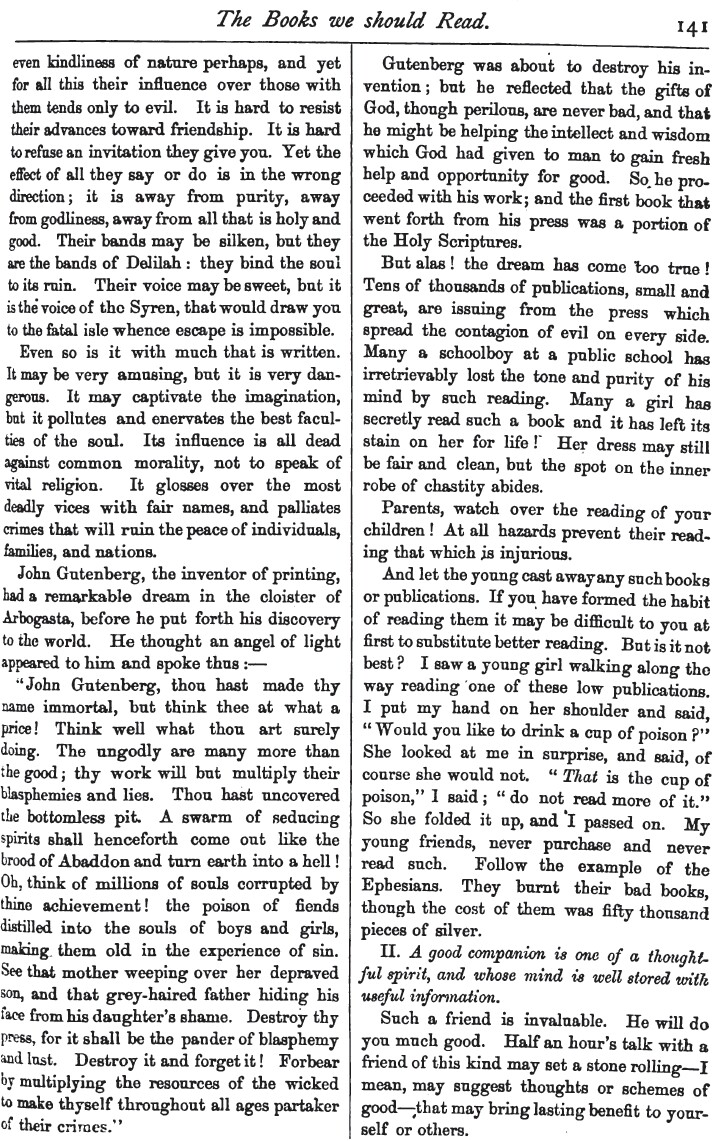
|
ISLAM AND THE PRINTING PRESS
|
January 21, 2016
Good comments on Daniel 1
Remember this was written nearly 200 years ago!

January 13, 2016
WWJD coined by Spurgeon?
From Grace Gems:(Charles Spurgeon, "The Fair Portrait of a Saint" 1880)
"My feet have closely followed His steps--I have kept to His way without turning aside." Job 23:11
A very beautiful motto is hung up in our classroom at the Stockwell Orphanage, "What would Jesus do?" Not only may children take it as their guide, but all of us may do the same, whatever our age.
"What would Jesus do?"
If you desire to know what you ought to do under any circumstances, imagine Jesus to be in that position and then think, "What would Jesus do? For what Jesus would do--that ought I to do."
This principle unties the knot of all moral difficulty in the most practical way, and does it so simply that no great wit or wisdom will be needed.
"I have set you an example that you should do as I have done for you." John 13:15
"Christ, who suffered for you, is your example. Follow in His steps." 1 Peter 2:21
"Whoever claims to live in Him, must walk as Jesus did." 1 John 2:6
January 4, 2016
Importance of Notetaking:
What a young man's notetaking produced that changed the world of
commentaries
That young man was Matthew Henry, probably the most widely read of all
Bible commentators. From an old encyclopedia: